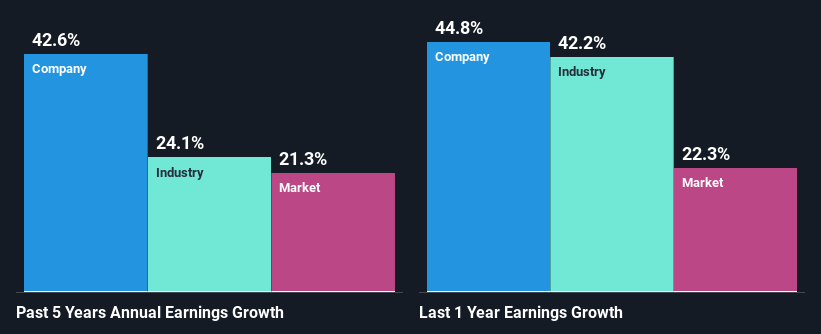Stock Analysis
- India
- /
- Electrical
- /
- NSEI:TDPOWERSYS
Are Strong Financial Prospects The Force That Is Driving The Momentum In TD Power Systems Limited's NSE:TDPOWERSYS) Stock?

Most readers would already be aware that TD Power Systems' (NSE:TDPOWERSYS) stock increased significantly by 20% over the past month. Given that the market rewards strong financials in the long-term, we wonder if that is the case in this instance. Specifically, we decided to study TD Power Systems' ROE in this article.
ROE or return on equity is a useful tool to assess how effectively a company can generate returns on the investment it received from its shareholders. In short, ROE shows the profit each dollar generates with respect to its shareholder investments.
See our latest analysis for TD Power Systems
How To Calculate Return On Equity?
The formula for return on equity is:
Return on Equity = Net Profit (from continuing operations) ÷ Shareholders' Equity
So, based on the above formula, the ROE for TD Power Systems is:
19% = ₹1.2b ÷ ₹6.6b (Based on the trailing twelve months to December 2023).
The 'return' is the amount earned after tax over the last twelve months. One way to conceptualize this is that for each ₹1 of shareholders' capital it has, the company made ₹0.19 in profit.
What Is The Relationship Between ROE And Earnings Growth?
So far, we've learned that ROE is a measure of a company's profitability. We now need to evaluate how much profit the company reinvests or "retains" for future growth which then gives us an idea about the growth potential of the company. Assuming everything else remains unchanged, the higher the ROE and profit retention, the higher the growth rate of a company compared to companies that don't necessarily bear these characteristics.
TD Power Systems' Earnings Growth And 19% ROE
At first glance, TD Power Systems seems to have a decent ROE. On comparing with the average industry ROE of 15% the company's ROE looks pretty remarkable. This probably laid the ground for TD Power Systems' significant 43% net income growth seen over the past five years. We reckon that there could also be other factors at play here. For example, it is possible that the company's management has made some good strategic decisions, or that the company has a low payout ratio.
Next, on comparing with the industry net income growth, we found that TD Power Systems' growth is quite high when compared to the industry average growth of 24% in the same period, which is great to see.

Earnings growth is a huge factor in stock valuation. The investor should try to establish if the expected growth or decline in earnings, whichever the case may be, is priced in. Doing so will help them establish if the stock's future looks promising or ominous. Is TD Power Systems fairly valued compared to other companies? These 3 valuation measures might help you decide.
Is TD Power Systems Efficiently Re-investing Its Profits?
TD Power Systems has a really low three-year median payout ratio of 14%, meaning that it has the remaining 86% left over to reinvest into its business. So it looks like TD Power Systems is reinvesting profits heavily to grow its business, which shows in its earnings growth.
Moreover, TD Power Systems is determined to keep sharing its profits with shareholders which we infer from its long history of paying a dividend for at least ten years.
Conclusion
On the whole, we feel that TD Power Systems' performance has been quite good. In particular, it's great to see that the company is investing heavily into its business and along with a high rate of return, that has resulted in a sizeable growth in its earnings. If the company continues to grow its earnings the way it has, that could have a positive impact on its share price given how earnings per share influence long-term share prices. Remember, the price of a stock is also dependent on the perceived risk. Therefore investors must keep themselves informed about the risks involved before investing in any company. To know the 2 risks we have identified for TD Power Systems visit our risks dashboard for free.
Valuation is complex, but we're helping make it simple.
Find out whether TD Power Systems is potentially over or undervalued by checking out our comprehensive analysis, which includes fair value estimates, risks and warnings, dividends, insider transactions and financial health.
View the Free AnalysisHave feedback on this article? Concerned about the content? Get in touch with us directly. Alternatively, email editorial-team (at) simplywallst.com.
This article by Simply Wall St is general in nature. We provide commentary based on historical data and analyst forecasts only using an unbiased methodology and our articles are not intended to be financial advice. It does not constitute a recommendation to buy or sell any stock, and does not take account of your objectives, or your financial situation. We aim to bring you long-term focused analysis driven by fundamental data. Note that our analysis may not factor in the latest price-sensitive company announcements or qualitative material. Simply Wall St has no position in any stocks mentioned.
About NSEI:TDPOWERSYS
TD Power Systems
TD Power Systems Limited, together with its subsidiaries, manufactures and sells AC generators and electric motors in India and internationally.
Flawless balance sheet with solid track record.

